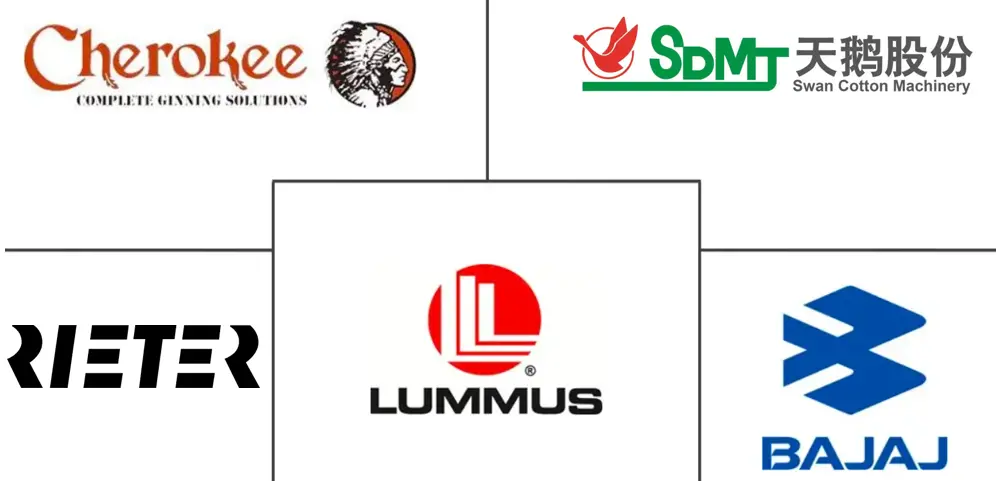Cotton Processing Market Size and Share
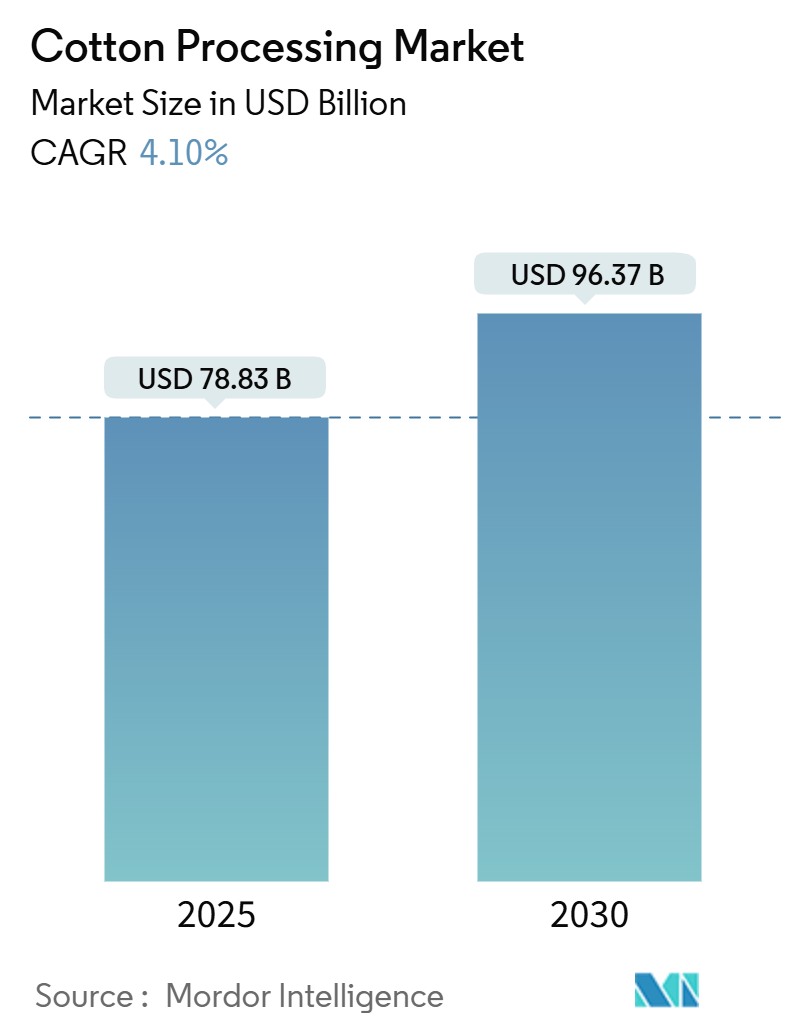
Cotton Processing Market Analysis by Mordor Intelligence
The Cotton Processing Market size is estimated at USD 78.83 billion in 2025, and is expected to reach USD 96.37 billion by 2030, at a CAGR of 4.10% during the forecast period (2025-2030).
The global cotton processing market is experiencing significant growth due to increasing demand for cotton-based products in various industries, advancements in processing technologies, and a rising preference for sustainable natural fibers in the textile industry. Cotton remains essential to the textile and apparel sector by meeting the demand for comfortable and durable fabrics. The market expansion is supported by increasing consumer preference for natural and biodegradable textiles.
The fashion and home textile industries demonstrate strong demand for cotton products. Cotton's properties of versatility, softness, and breathability make it suitable for various applications, including apparel, bed linens, towels, and upholstery. Raw cotton serves as an irreplaceable key ingredient in textile manufacturing. The textile segment accounts for the largest share of the global cotton processing market. The market is also driven by demand from the medical and surgical sectors, where cotton lint is used in manufacturing surgical bandages, apparel, and household textiles.
North America and Europe maintain consistent demand for premium cotton textiles. In emerging economies like China and India, increased disposable incomes and changing fashion trends have elevated cotton consumption. African nations are expanding their cotton production area and implementing high-yield varieties to meet demand from Asian textile manufacturers. FAOSTATS data shows Africa's cotton harvested area increased from 4.72 million hectares in 2022 to 4.84 million hectares in 2023. Furthermore, in July 2024, the Egyptian government also launched an initiative to boost cotton production and processing.
Major producing countries are focusing on export enhancement to meet global demand. In 2022, India's NAEC president proposed measures including cotton export control, elimination of 10 percent cotton import duty, and implementation of price regulation mechanisms for cotton and raw materials to support the sector. According to the ITC Trade Map, the major importers of cotton in 2023 include China, Vietnam, Bangladesh, and Turkey. In 2023, China imported cotton worth USD 8.98 billion, while Bangladesh imported USD 6.69 billion. The United States, China, India, Brazil, and Pakistan are the leading exporters of cotton in 2023, as reported by ITC Trade Map.
The global cotton processing market continues to grow through product demand, technological advancement, and sustainable fiber adoption. The market shows potential for continued growth during the forecast period as consumer preferences and industry practices evolve.
Global Cotton Processing Market Trends and Insights
Textile Segment Dominates The Market
The rising demand for textiles, particularly cotton-based products, drives growth in the global cotton processing market. Cotton's superior qualities, including softness, breathability, and versatility, make it a preferred raw material in the textile and apparel industries. As consumer demand for high-quality, comfortable, and sustainable clothing increases, the cotton processing market continues to expand.
The growing global population is a key factor driving textile demand through increased consumption of clothing and home textiles. The United Nations projects the global population to reach approximately 9.7 billion by 2050, necessitating increased textile production. The expanding middle class in emerging economies, particularly in Asia-Pacific, has accelerated this trend. India, China, the United States, Brazil, and Pakistan are the main producing countries, accounting for more than 75% of global production, according to FAO data. FAOSTATS reports that the cotton harvested area in Brazil increased to 1.71 million hectares in 2023 from 1.64 million hectares in 2022.
Fashion and lifestyle trends significantly influence the textile industry. The fast fashion sector, with its quick production cycles and affordable prices, has increased cotton demand due to its use in casual and everyday wear. Additionally, premium and luxury fashion brands drive demand for high-grade cotton fabrics that provide superior aesthetics and durability.
The home textile segment, comprising bed linens, towels, curtains, and upholstery, contributes substantially to market growth. Global demand increases are reflected in processed cotton imports. According to the ITC Trade Map, China's cotton imports rose to 1.95 million metric tons in 2023 from 1.92 million metric tons in 2022. Cotton processors are adapting their strategies to provide high-quality fibers suitable for home textile applications.
The expansion of the global textile industry, particularly in emerging markets, is anticipated to generate significant investments in the cotton processing market during the forecast period. With growing applications in apparel, home textiles, and technical textiles, cotton processors are positioned to meet the textile industry's evolving demands.
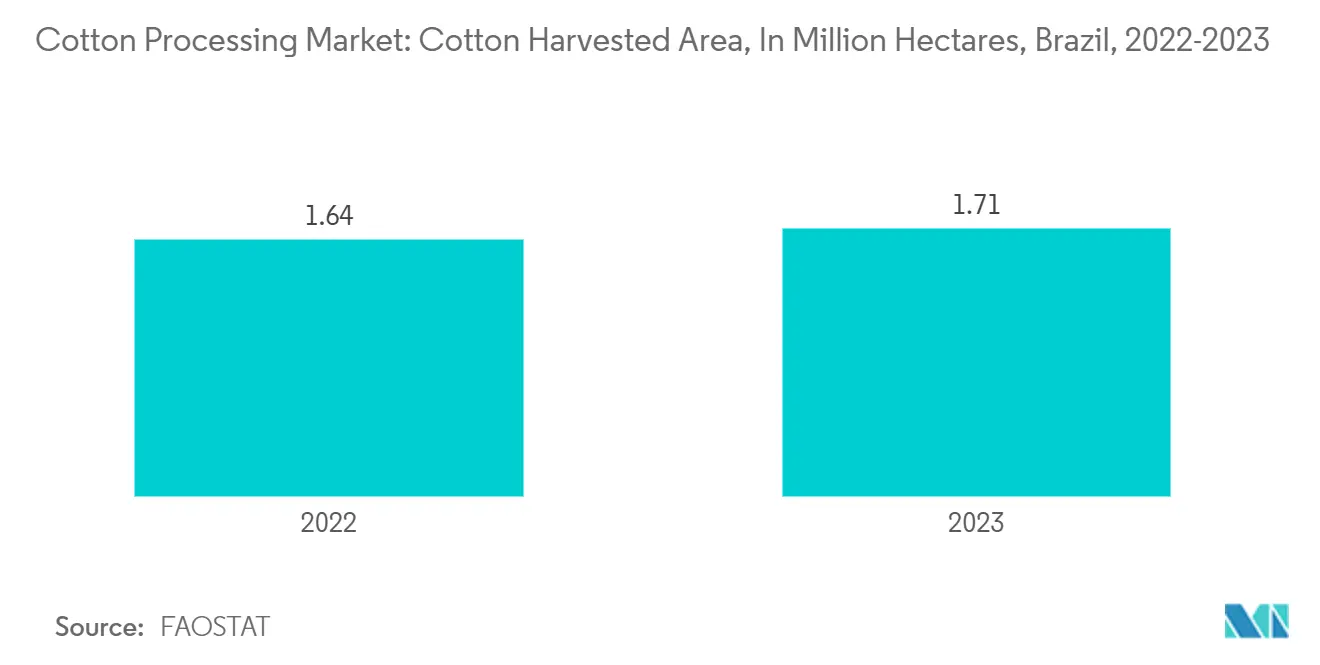
Asia Pacific is the Largest Cotton Processing Market
Asia-Pacific holds the largest share of the global cotton processing market, driven by its dominance in textile production, abundant raw cotton availability, and a strong consumer base for cotton-based products. The region's prominence stems from its role as a global textile hub, with countries like China, India, Pakistan, and Vietnam leading the industry in both raw cotton processing and the production of finished textiles. According to the Ministry of Textile, Government of India, the total global area under cotton cultivation reached 31.8 million hectares in 2023. India leads global cotton cultivation, accounting for 39% of the global area under cotton cultivation, with 12.9 million hectares in 2023, an increase from 12.3 million hectares in 2022.
The textile industry in Asia-Pacific benefits from low production costs, a skilled workforce, and significant government support. China and India are among the world's largest producers and consumers of cotton, accounting for a substantial portion of global cotton output. In 2022, the Cotton Corporation of India Limited partnered with the Cotton Textiles Export Promotion Council to market Kasturi cotton globally, expanding the reach of Indian cotton textile products.
China maintains its position as a major global cotton producer through high-yield production techniques. The Xinjiang region, accounting for over 80% of China's total output, benefits from favorable climate conditions, advanced irrigation systems, and large-scale mechanized farming, according to the National Bureau of Statistics of China (NBSC). This production capacity enables China to meet both domestic and international demand. Further rising disposable incomes and urbanization in India, Indonesia, and Vietnam have increased the consumption of cotton-based apparel and home textiles. Consumer preference for comfortable, durable, and sustainable fabrics has boosted demand for cotton products. The region's export focus, supplying textiles and apparel to North America, Europe, and the Middle East, drives investment in advanced cotton processing technologies. India's exports of cotton yarn other than sewing thread (containing 85% or more cotton by weight) increased from 671.1 thousand metric tons in 2022 to 1,084.5 thousand metric tons in 2023.
Asia-Pacific's leadership in textile production, combined with its raw cotton supply, and export orientation, maintains its position as the largest market for global cotton processing. This regional dominance is anticipated to continue as the industry adapts to consumer preferences and technological advancements.
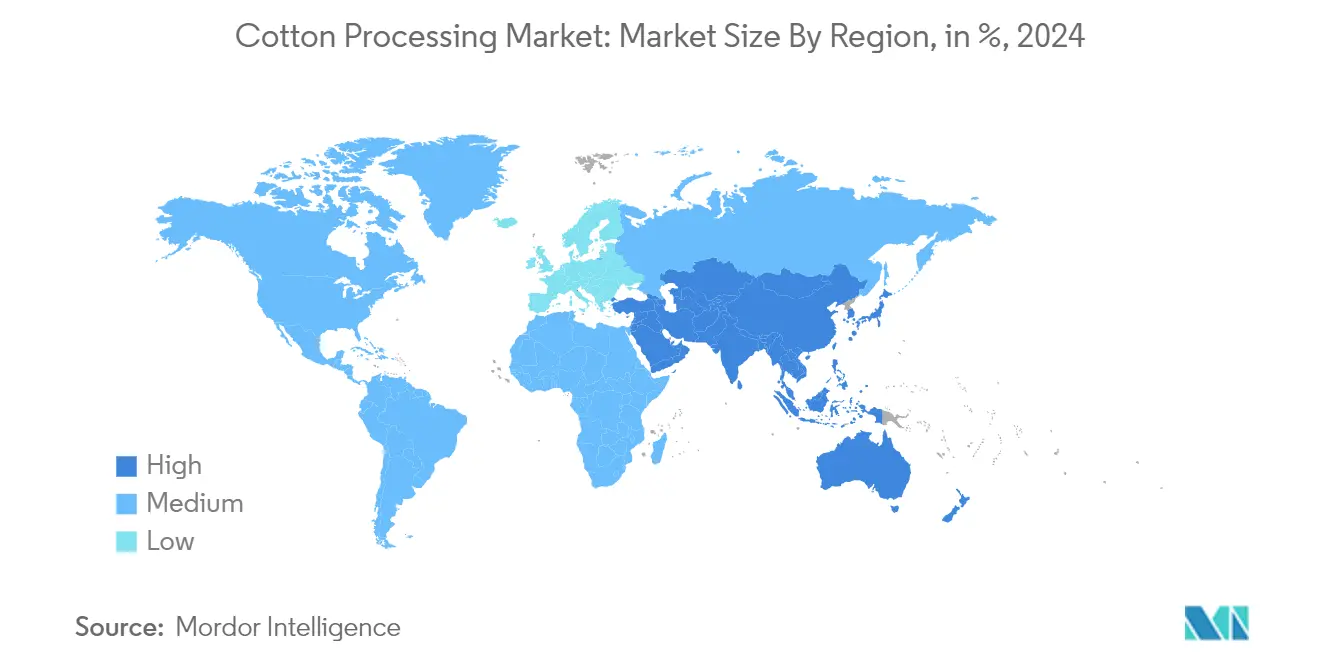
Competitive Landscape
The global cotton processing market is consolidated, with a few significant players occupying most of the market share. The leading players in the market, like Lummus Corp. Cherokee Fabrication, Shandong Swan Cotton Industrial Machinery Stock Co., Rieter Group, and Bajaj Group of Companies, focus on increasing their presence through undertaking investments and expansions and developing products specific to consumer preferences in these regions. Most of the major companies have a strong presence in the Asia Pacific and North American regions.
Cotton Processing Industry Leaders
-
Lummus Corp.
-
Bajaj Group of Companies
-
Shandong Swan Cotton Industrial Machinery Stock Co.
-
Cherokee Fabrication
-
Rieter Group
- *Disclaimer: Major Players sorted in no particular order
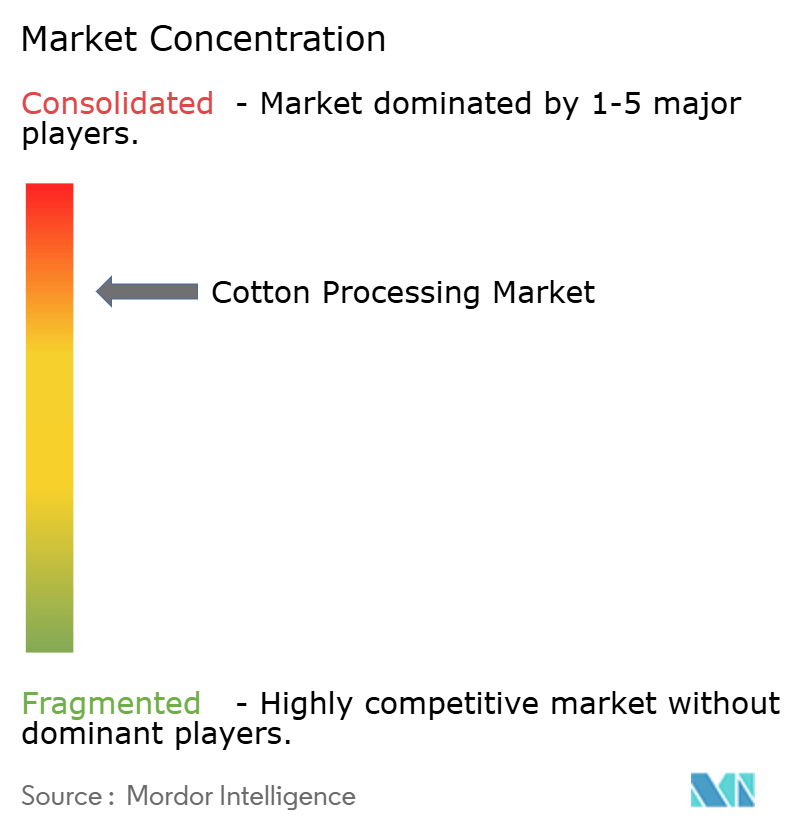
Recent Industry Developments
- October 2023: The Cotton Corporation of India unveiled the Bale Identification and Traceability System (BITS), harnessing Blockchain Technology. Each cotton bale is now equipped with a QR code, facilitating seamless tracking of its origin, processing location, storage specifics, and quality metrics, complete with timestamps.
- December 2022: The Cotton Corporation of India Limited and the Cotton Textiles Export Promotion Council signed an agreement to globally market Kasturi cotton, a domestically produced brand. This collaboration promotes domestic cotton processing and the worldwide export of Indian cotton textile products.
- May 2022: The Pakistan government decided to offer incentives to the farmers to enable them to switch from the water-intensive sugarcane crop to cotton production to rely less on processed cotton imports and enhance cotton production and processing.
Global Cotton Processing Market Report Scope
The cotton processing market includes machinery used to convert raw cotton into forms utilized by several industries, like medical and textile. The Cotton Processing Market is Segmented by Product Type (Lint, Cottonseed, and Other Product Types), Application (Textiles, Surgical and Medical, Feed, and Other Applications), Equipment (Spinning, Ginning, and Other Equipment), Operation (Automatic, Semi-automatic, and Other Operations), and Geography (North America, Europe, Asia Pacific, South America, and Africa). The report offers market sizing and forecasts in terms of value (USD) for all the above segments.
| Lint |
| Cottonseed |
| Other Product Types |
| Textiles |
| Surgical and Medical |
| Feed |
| Other Applications |
| Spinning |
| Ginning |
| Other Equipment |
| Automatic |
| Semi-Automatic |
| Other Operations |
| North America | United States |
| Canada | |
| Mexico | |
| Rest of North America | |
| Europe | United Kingdom |
| France | |
| Italy | |
| Spain | |
| Germany | |
| Rest of Europe | |
| Asia Pacific | China |
| India | |
| Japan | |
| Australia | |
| Rest of Asia Pacific | |
| South America | Brazil |
| Argentina | |
| Rest of South America | |
| Africa | South Africa |
| Rest of Africa |
| Cotton Product Type | Lint | |
| Cottonseed | ||
| Other Product Types | ||
| Application | Textiles | |
| Surgical and Medical | ||
| Feed | ||
| Other Applications | ||
| Equipment | Spinning | |
| Ginning | ||
| Other Equipment | ||
| Operation | Automatic | |
| Semi-Automatic | ||
| Other Operations | ||
| Geography | North America | United States |
| Canada | ||
| Mexico | ||
| Rest of North America | ||
| Europe | United Kingdom | |
| France | ||
| Italy | ||
| Spain | ||
| Germany | ||
| Rest of Europe | ||
| Asia Pacific | China | |
| India | ||
| Japan | ||
| Australia | ||
| Rest of Asia Pacific | ||
| South America | Brazil | |
| Argentina | ||
| Rest of South America | ||
| Africa | South Africa | |
| Rest of Africa | ||
Key Questions Answered in the Report
How big is the Cotton Processing Market?
The Cotton Processing Market size is expected to reach USD 78.83 billion in 2025 and grow at a CAGR of 4.10% to reach USD 96.37 billion by 2030.
What is the current Cotton Processing Market size?
In 2025, the Cotton Processing Market size is expected to reach USD 78.83 billion.
Who are the key players in Cotton Processing Market?
Lummus Corp., Bajaj Group of Companies, Shandong Swan Cotton Industrial Machinery Stock Co., Cherokee Fabrication and Rieter Group are the major companies operating in the Cotton Processing Market.
Which is the fastest growing region in Cotton Processing Market?
Asia Pacific is estimated to grow at the highest CAGR over the forecast period (2025-2030).
Which region has the biggest share in Cotton Processing Market?
In 2025, the Asia Pacific accounts for the largest market share in Cotton Processing Market.
What years does this Cotton Processing Market cover, and what was the market size in 2024?
In 2024, the Cotton Processing Market size was estimated at USD 75.60 billion. The report covers the Cotton Processing Market historical market size for years: 2019, 2020, 2021, 2022, 2023 and 2024. The report also forecasts the Cotton Processing Market size for years: 2025, 2026, 2027, 2028, 2029 and 2030.
Page last updated on:
Cotton Processing Market Report
Statistics for the 2025 Cotton Processing market share, size and revenue growth rate, created by Mordor Intelligence™ Industry Reports. Cotton Processing analysis includes a market forecast outlook for 2025 to 2030 and historical overview. Get a sample of this industry analysis as a free report PDF download.
